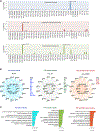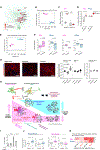Tau Pathology Drives Dementia Risk-Associated Gene Networks toward Chronic Inflammatory States and Immunosuppression
- PMID: 33207193
- PMCID: PMC7842189
- DOI: 10.1016/j.celrep.2020.108398
Tau Pathology Drives Dementia Risk-Associated Gene Networks toward Chronic Inflammatory States and Immunosuppression
Abstract
To understand how neural-immune-associated genes and pathways contribute to neurodegenerative disease pathophysiology, we performed a systematic functional genomic analysis in purified microglia and bulk tissue from mouse and human AD, FTD, and PSP. We uncover a complex temporal trajectory of microglial-immune pathways involving the type 1 interferon response associated with tau pathology in the early stages, followed by later signatures of partial immune suppression and, subsequently, the type 2 interferon response. We find that genetic risk for dementias shows disease-specific patterns of pathway enrichment. We identify drivers of two gene co-expression modules conserved from mouse to human, representing competing arms of microglial-immune activation (NAct) and suppression (NSupp) in neurodegeneration. We validate our findings by using chemogenetics, experimental perturbation data, and single-cell sequencing in post-mortem brains. Our results refine the understanding of stage- and disease-specific microglial responses, implicate microglial viral defense pathways in dementia pathophysiology, and highlight therapeutic windows.
Keywords: chemical genomics; frontotemporal dementia; gene network; inflammasome; interferon; neurodegeneration; progressive supranuclear palsy; systems biology; transcriptomics.
Published by Elsevier Inc.
Conflict of interest statement
Declaration of Interests D.H.G. has received research funding from Takeda Pharmaceuticals and Hoffman-LaRoche. D.M. is a full-time employee of F. Hoffmann-La Roche, Basel, Switzerland.
Figures






References
-
- Benjamini Y, and Hochberg Y (1995). Controlling the false discovery rate: a practical and powerful approach to multiple testing. J. R. Stat. Soc. B 57, 289–300.
Publication types
MeSH terms
Substances
Grants and funding
LinkOut - more resources
Full Text Sources
Medical
Molecular Biology Databases
Miscellaneous

